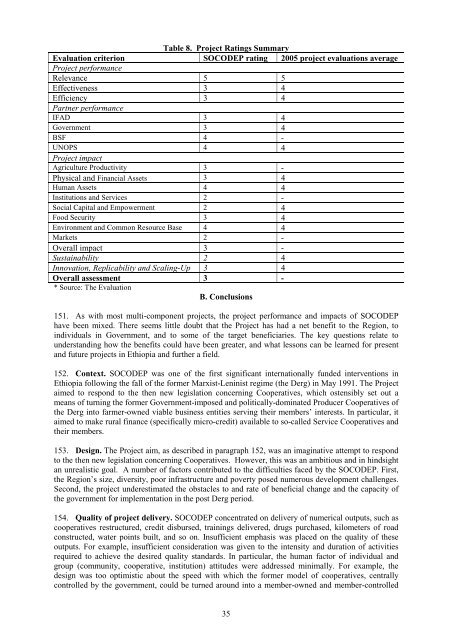Ethiopia SOCODEP CE - main report - IFAD
Ethiopia SOCODEP CE - main report - IFAD
Ethiopia SOCODEP CE - main report - IFAD
You also want an ePaper? Increase the reach of your titles
YUMPU automatically turns print PDFs into web optimized ePapers that Google loves.
Table 8. Project Ratings Summary<br />
Evaluation criterion <strong>SOCODEP</strong> rating 2005 project evaluations average<br />
Project performance<br />
Relevance 5 5<br />
Effectiveness 3 4<br />
Efficiency 3 4<br />
Partner performance<br />
<strong>IFAD</strong> 3 4<br />
Government 3 4<br />
BSF 4 -<br />
UNOPS 4 4<br />
Project impact<br />
Agriculture Productivity 3 -<br />
Physical and Financial Assets 3 4<br />
Human Assets 4 4<br />
Institutions and Services 2 -<br />
Social Capital and Empowerment 2 4<br />
Food Security 3 4<br />
Environment and Common Resource Base 4 4<br />
Markets 2 -<br />
Overall impact 3 -<br />
Sustainability 2 4<br />
Innovation, Replicability and Scaling-Up 3 4<br />
Overall assessment 3 -<br />
* Source: The Evaluation<br />
B. Conclusions<br />
151. As with most multi-component projects, the project performance and impacts of <strong>SOCODEP</strong><br />
have been mixed. There seems little doubt that the Project has had a net benefit to the Region, to<br />
individuals in Government, and to some of the target beneficiaries. The key questions relate to<br />
understanding how the benefits could have been greater, and what lessons can be learned for present<br />
and future projects in <strong>Ethiopia</strong> and further a field.<br />
152. Context. <strong>SOCODEP</strong> was one of the first significant internationally funded interventions in<br />
<strong>Ethiopia</strong> following the fall of the former Marxist-Leninist regime (the Derg) in May 1991. The Project<br />
aimed to respond to the then new legislation concerning Cooperatives, which ostensibly set out a<br />
means of turning the former Government-imposed and politically-dominated Producer Cooperatives of<br />
the Derg into farmer-owned viable business entities serving their members’ interests. In particular, it<br />
aimed to make rural finance (specifically micro-credit) available to so-called Service Cooperatives and<br />
their members.<br />
153. Design. The Project aim, as described in paragraph 152, was an imaginative attempt to respond<br />
to the then new legislation concerning Cooperatives. However, this was an ambitious and in hindsight<br />
an unrealistic goal. A number of factors contributed to the difficulties faced by the <strong>SOCODEP</strong>. First,<br />
the Region’s size, diversity, poor infrastructure and poverty posed numerous development challenges.<br />
Second, the project underestimated the obstacles to and rate of beneficial change and the capacity of<br />
the government for implementation in the post Derg period.<br />
154. Quality of project delivery. <strong>SOCODEP</strong> concentrated on delivery of numerical outputs, such as<br />
cooperatives restructured, credit disbursed, trainings delivered, drugs purchased, kilometers of road<br />
constructed, water points built, and so on. Insufficient emphasis was placed on the quality of these<br />
outputs. For example, insufficient consideration was given to the intensity and duration of activities<br />
required to achieve the desired quality standards. In particular, the human factor of individual and<br />
group (community, cooperative, institution) attitudes were addressed minimally. For example, the<br />
design was too optimistic about the speed with which the former model of cooperatives, centrally<br />
controlled by the government, could be turned around into a member-owned and member-controlled<br />
35

















